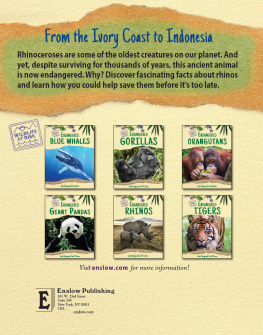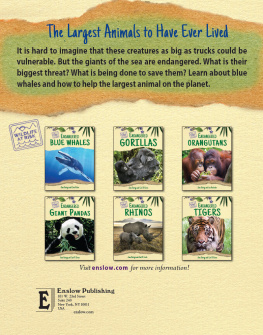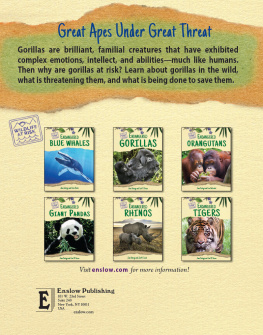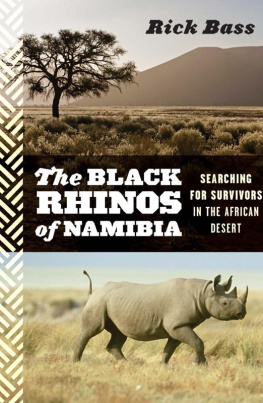Jan M. Czech - Endangered Rhinos
Here you can read online Jan M. Czech - Endangered Rhinos full text of the book (entire story) in english for free. Download pdf and epub, get meaning, cover and reviews about this ebook. year: 2015, publisher: Enslow Publishing, LLC, genre: Politics. Description of the work, (preface) as well as reviews are available. Best literature library LitArk.com created for fans of good reading and offers a wide selection of genres:
Romance novel
Science fiction
Adventure
Detective
Science
History
Home and family
Prose
Art
Politics
Computer
Non-fiction
Religion
Business
Children
Humor
Choose a favorite category and find really read worthwhile books. Enjoy immersion in the world of imagination, feel the emotions of the characters or learn something new for yourself, make an fascinating discovery.
- Book:Endangered Rhinos
- Author:
- Publisher:Enslow Publishing, LLC
- Genre:
- Year:2015
- Rating:3 / 5
- Favourites:Add to favourites
- Your mark:
- 60
- 1
- 2
- 3
- 4
- 5
Endangered Rhinos: summary, description and annotation
We offer to read an annotation, description, summary or preface (depends on what the author of the book "Endangered Rhinos" wrote himself). If you haven't found the necessary information about the book — write in the comments, we will try to find it.
Rhinoceroses are some of the oldest creatures on our planet. And yet, despite surviving for thousands of years, this ancient animal is now endangered. Why? Discover fascinating facts about rhinos and learn how you could help save them before its too late.
Endangered Rhinos — read online for free the complete book (whole text) full work
Below is the text of the book, divided by pages. System saving the place of the last page read, allows you to conveniently read the book "Endangered Rhinos" online for free, without having to search again every time where you left off. Put a bookmark, and you can go to the page where you finished reading at any time.
Font size:
Interval:
Bookmark:

Published in 2016 by Enslow Publishing, LLC.
101 W. 23rd Street, Suite 240, New York, NY 10011
Copyright 2016 by Enslow Publishing, LLC.
All rights reserved.
No part of this book may be reproduced by any means without the written permission of the publisher.
Library of Congress Cataloging-in-Publication Data
Katirgis, Jane, author.
Endangered rhinos / Jane Katirgis and Jan M. Czech.
pages cm. (Wildlife at risk)
Summary: Discusses rhinos, why they are endangered and whats being done to help Provided by publisher.
Audience: Ages 11+
Audience: Grades 7 to 8
Includes bibliographical references and index.
ISBN 978-0-7660-6902-2 (library binding)
ISBN 978-0-7660-6900-8 (pbk.)
ISBN 978-0-7660-6901-5 (6-pack)
1. RhinocerosesJuvenile literature. 2. Rare mammalsJuvenile literature. I. Czech, Jan M., author. II. Title.
QL737.U63K38 2016
599.668dc23
2015010127
Printed in the United States of America
To Our Readers: We have done our best to make sure all Web site addresses in this book were active and appropriate when we went to press. However, the author and the publisher have no control over and assume no liability for the material available on those Web sites or on any Web sites they may link to. Any comments or suggestions can be sent by e-mail to .
Portions of this book originally appeared in the book The Rhino.
Photos Credits: A. Bayley-Worthington/Todd/Getty Images, p..
Cover Credits: Chris Minihane/Moment/Getty Images (rhinos); Creativ Studio Heinemann/Creative (RF)/Getty Images (borage flowers); Joakim Leroy/E+/Getty Images (palm leaf); Maria Toutoudaki/ Photodisk/Getty Images (background paper texture).
RHINOS AT A GLANCE
Scientific Name
There are five species of rhinoceros and eleven subspecies.
Black Rhino: Diceros bicornis
White Rhino: Ceratotherium simum
Indian Rhino: Rhinoceros unicornis
Javan Rhino: Rhinoceros sondaicus
Sumatran Rhino: Dicerorhinus sumatrensis
Average Height
4 to 6 feet (1.2 to 1.8 m) to the shoulder
Average Weight
The five species of rhinos range from 750 pounds to 8,000 pounds (340 kg to 3,629 kg).
Life Span
In the wild, up to thirty-five years; in captivity, forty years or longer
Status
Endangered
Skin Color
Gray or brown
Teeth
Rhinos have between twenty-four and thirty-four teeth depending on the species.
Breeding Season
No particular season
Gestation Period
Varies by species but averages sixteen months
Range
Black rhinos and white rhinos are found in Africa; Javan, Indian, and Sumatran rhinos are found in Asia.
Maximum Speed
30 miles per hour (48 km per hour)
Main Threat to Survival
Humans who kill rhinos for their horns and destroy their habitat.
chapter one
THE ANCIENT RHINO
When you think of a rhinoceros, commonly called a rhino, you probably think of Africa or Asia but not Nebraska. But this large herbivore was once one of many other animals gathering around a watering hole in North America. They are long extinct in that area, but it is fascinating to think of these large beasts roaming the land with camels, horses, deer, and other animals in the area.
The rhinoceros is one of the worlds most ancient animal species. It has roamed the planet for almost 50 million years. Until about 3 million years ago, rhinos were the most common land mammal in North America. There were once many more kinds of rhinos, including hornless rhinos, wooly rhinos, and the Indricotherium, which are all now extinct.
In the case of the Indricotherium, that is probably a good thing. It was the largest land mammal in the earths history. This giant member of the rhinoceros family stood between 18 and 23 feet (5 and 7 m) tall, was 27 feet (8 m) long, and weighed about 66,000 pounds (30,000 kg). It was eight times the size of modern rhinosas large as most houses. Other ancient rhinos looked more like horses or giraffes than their modern-day counterparts. Some scientists think that the mythical unicorn may be based on an ancient horselike one-horned rhino.
The Indricotherium, like the dinosaur and many other ancient species, no longer exists. Its modern relatives in the rhino family face the same fatethat of becoming extinct. There are now only five species and eleven subspecies of rhino, and they are found only in Africa and Asia. How could an animal that has been around for millions of years and was once so common be in danger of disappearing from the face of the earth?
Numbers on the Increase
Despite the problems of poaching, overall numbers of rhinos are steadily increasing. But human beings pose the biggest threat to the rhino population through hunting and developing the lands that once made up the rhinos habitat. Humans have made successful attempts to build up and protect the rhino population. Yet some rhino species are now among the most critically endangered animals. The International Rhino Foundation (IRF), which supports and operates rhino conservation programs, reports that as of 2013 there were about 28,877 rhinos left in the wild. According to the IRF, there are about 20,400 white rhinos, 5,000 black rhinos, 3,333 Indian rhinos, no more than 44 Javan rhinos, and 100 Sumatran rhinos. These last two Asian rhino species are on the verge of extinction.
Fast Fact!
The Sumatran rhino has been on earth longer than any other mammal living today.
Hunting Rhinos
The word rhinoceros comes from the Greek rhino, which means nose, and ceros, which means horn. Rhino horns are made of tightly packed hair called keratin, which is like human hair and nails. Rhinos use their horns to defend themselves against other animals. Unfortunately, it is for their horns that people hunt rhinos because those horns are highly valued in certain cultures and fetch a huge amount of money.
Poachers, or people who take or kill wild animals illegally, hunt rhinos on wildlife refuges where they are supposed to be protected. Rhinos are also hunted in the wild in their natural habitats. Rhinos often die slowly after being shot with guns or arrows. Many times, their horns are taken while they are still alive.
Although it is illegal to trade in rhino horn, poachers still supply the market with illegal rhino horn. In the 1970s and 1980s, artisans in Yemen, an Asian country at the southern tip of the Arabian peninsula, commonly used rhino horn to make handles for knives called jambiyas. Jambiyas are considered precious, like a Rolex watch, and in many families they are handed down from generation to generation. But this use of rhino horn is now responsible for fewer and fewer poaching incidents. More rhino horns are now being sold in eastern Asia to be ground up and used in medicines. The rhino horn is the most important part of the rhino to hunters, but rhino nails, hooves, blood, urine, and hide are also traded and used in medicines.

A hunter poses with a rhinoceros he killed around 1890.
Efforts continue to protect this ancient animal, but time and tradition are both hurdles to the rhinos survival. And humans, who pose the greatest threat to the rhinos numbers, are the only ones who can now save it.
Fast Fact!
The Southern white rhino was once on the brink of extinction; there were only about 50 of them left in the wild. Today, their numbers exceed 20,000.
Font size:
Interval:
Bookmark:
Similar books «Endangered Rhinos»
Look at similar books to Endangered Rhinos. We have selected literature similar in name and meaning in the hope of providing readers with more options to find new, interesting, not yet read works.
Discussion, reviews of the book Endangered Rhinos and just readers' own opinions. Leave your comments, write what you think about the work, its meaning or the main characters. Specify what exactly you liked and what you didn't like, and why you think so.









